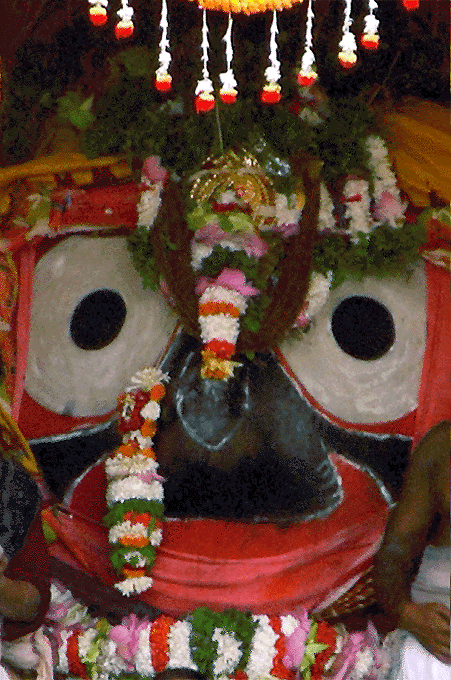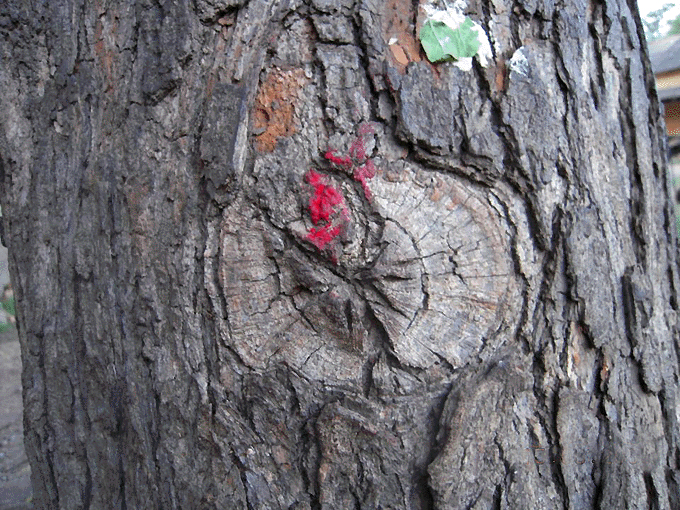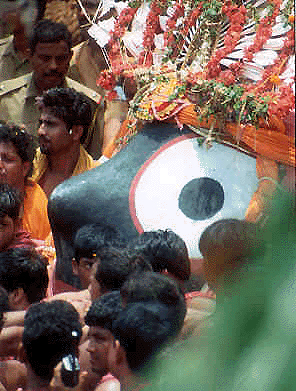
|
|
|
|
BY: SUN STAFF

Jun 09, 2011 — CANADA (SUN) — A two-part study of the ancient Naba Kalebar Yatra rites of Lord Jagannatha at Puri Dham, by Saumya Ranjan Swain. When the Daru tree is found for Naba Kalebar Yatra, a great holy fire sacrifice is performed there to invite all the gods and goddesses to come and give their blessings at this auspicious time. Nearby the members of the search party constructs a small thatched hut in which they will now reside. After the day of the fire sacrifice the actual cutting of the tree can begin. The Pati Mahapatra will touch the tree to be used for Lord Jagannath with a golden axe. Then the Dayitapati will touch it with a silver axe. Lastly, the head wood carver of the Maharana family will touch it with an iron axe. During the tree cutting, the 108 names of God will be chanted. These will be different names of Patala Nrusingha, who was worshipped before the appearance of Jagannath. His name is recited at all auspicious moments because He saves devotees from all problems; prayer to Him ensures that all will end well. The whole uncut trunk of the tree is then brought to the temple. It is placed on a wooden cart made at Jagannath Temple for this occasion and dragged back to the temple by the Dayitapatis with the help of the other members of the group. The logs are kept inside the temple in a place known as Koili Vaikuntha. Koili means "burial ground". It is the place where the old Deities will be buried and the new ones made. It is located near the Elephant Gate on the north side of the temple. The three oldest wood carvers will be the main sculptors for the Deity of Lord Jagannath. Three others will do Subhadra; and three others, Balabhadra. More than 50 others will assist, and also do Sudarshan. Nobody is allowed to go to this place during the 21 days or so when the new Deities are being made, not even the head priest of the temple. There is a very strong door and thick outer walls. The carpenters close the door from inside and work all day, although it is open to the sun overhead. The wood carvers are not allowed to eat or drink water inside this holy place, so they go to the temple courtyard to eat and sleep at night. During these 21 days they do not leave the temple. Devotional songs will be sung outside the main door of the Koili Vaikuntha day and night throughout, this period. Such constant singing of devotional songs is called akhanda-bhajana. While this is done by devadasis and temple musicians, slokas from the Vedas are chanted continuously by brahmanas. When the new Deities, are made, they will be carried inside the inner sanctum of the temple and placed in front of the old Deities, facing them. At this time nobody can go inside for darshan, not even the temple priests. The three new Deities are carried inside only by descendants of the Dayitapati family. Once they are safely inside, only the three eldest Dayitapati members can stay. No puja is done at this time, no food is offered.
Of the four Deities, Lord Jagannath's height is 5' 7", and His outstretched arms measure 12 ft. across. He weighs so much that when they carry Him, 5 persons must be on each arm, 20 on His backside, and more then 50 in front pulling. Balabhadra is a bit lighter. His height is 5' 5" and His arms are also 12 ft. across. Subhadra is less then 5', and light. Sudarsana is in a long log-shaped form only. However, this log is 5' 10" in length. Only the three oldest members of the Dayitapati family are present inside the temple on the most holy day of the Great Transformation Rite. Lord Jagannath was worshipped by them first, so only they can transfer "The Brahma" from the old Deities to the new. Not even the usual head priest who attends to Lord Jagannath can be present. This ceremony takes place three days before the great Chariot Festival. The three Dayitapatis must be blindfolded. They must bind a piece of Lord Jagannath's cloth around their hands before the transfer can begin. They should not have shaved since the first day of the search party procession. This is considered to be the disappearance ceremony of Jagannath also. Traditionally, after a member of the family passes away, the son does not shave for ten days, out of respect for the deceased. The house is also whitewashed after the death of any family member. So all Dayitapati families whitewash their houses at this time, as Lord Jagannath is considered the head of their household. The children and all Dayitapati family members wear new clothes on this day of the "transfer". This rite is considered to be the most auspicious ritual of all in Jagannath Temple. It is this ceremony itself that is the actual aNaba Kalebar Yatra', or Transformation Ceremony of Lord Jagannath. The three Dayitapati members fast and meditate the whole day inside the temple. Only after midnight does the transfer of the 'life force' occur, and that in total silence. When asked of their experience at this time, the Dayitapatis say, "It is very difficult to express what Brahma is. It can't be seen or touched. Our eyes are blindfolded and our hands are covered with cloth when we carry it. Yet a powerful feeling is very much present, like a rabbit jumping in our hands. This is our experience. Beyond this, exactly what this Brahma is that is so powerfully felt, nobody is able to say." The old Deities are carried on the shoulders of the Dayitapatis and buried in the Koili Vaikuntha before dawn. It is felt that Daru Brahma should not be burned in the usual cremation ceremony. The old Deities were the abode of Daru Brahma for at least 12 years, even though Daru Brahma is not present there now. So they arc simply buried, and not burned. There are three separate graves for the three Deities, but the entire previous Jagannaths are laid to rest in the same grave, one on top of the other. At other times of the year devotees may go inside the Koili Vaikuntha, but the actual spots of the graves are unmarked. It is said that if anybody from outside this select group happens to see any of this ceremony, be it from a roof top or otherwise, they will surely die. For this reason, the government of Orissa orders a full blackout of light for this one night in the whole town of Puri. On the morning of the second day, the town of Puri will seem lifeless, as if in mourning. The beloved old forms of Lord Jagannath, Balabhadra, and Subhadra are now gone, and people have yet to see the new ones. The new Deities are immediately seated on the altar, known as ratna-singhasana. On this second day, the daily routine of the temple finally begins again, after a lapse of nearly 58 days. Sweet-smelling flower garlands and new garments are given to the new Deities, food is offered, and puja is done. Devotees can again come inside for darshan. On the third day, the new Deities emerge from the temple for the biggest Chariot Festival of all. The annual Chariot Festival may draw 50,000 people, but on this most sacred occasion, more then 500,000 people will be present. Naba Kalebar Yatra is so holy, it draws more people to it every 12 years than any other festival of India, except the grand Kumbha Mela, which draws slightly more and is held every 12 years in Prayag, Allahabad. The next scheduled Naba Kalebar Yatra is expected to be held in 2015.

Neem tree bearing sacred marks found in Simulia, Balasore district, Orissa in 2009
| |
